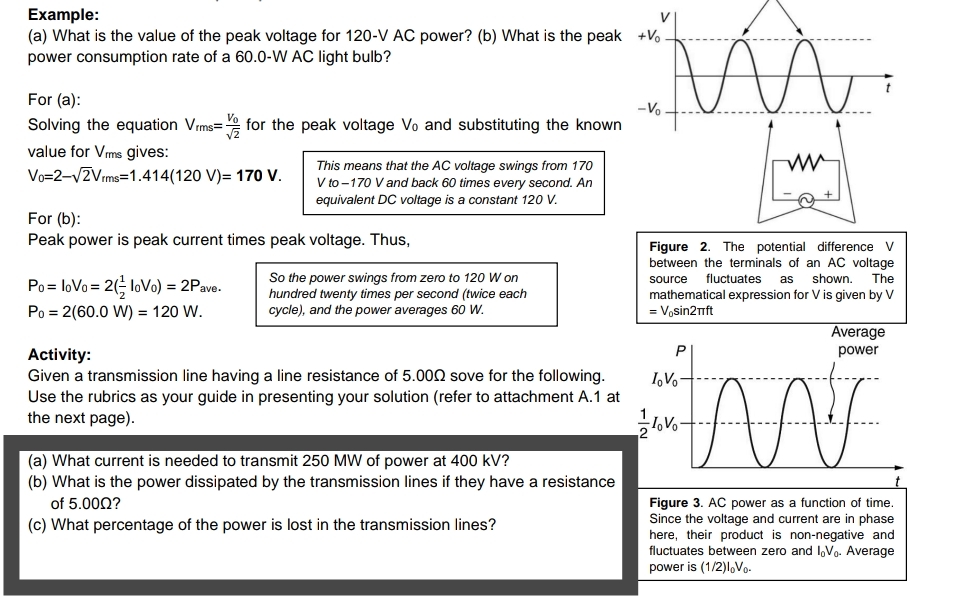(a) What current is needed to transmit 250 MW of power at 400 kV? (b) What is the power dissipated by the transmission lines if they have a resistance of 5.000? (c) What percentage of the power is lost in the transmission lines?
(a) What current is needed to transmit 250 MW of power at 400 kV? (b) What is the power dissipated by the transmission lines if they have a resistance of 5.000? (c) What percentage of the power is lost in the transmission lines?
Physics for Scientists and Engineers: Foundations and Connections
1st Edition
ISBN:9781133939146
Author:Katz, Debora M.
Publisher:Katz, Debora M.
Chapter33: Inductors And Ac Circuits
Section: Chapter Questions
Problem 80PQ
Related questions
Question

Transcribed Image Text:Example:
(a) What is the value of the peak voltage for 120-V AC power? (b) What is the peak +V,
power consumption rate of a 60.0-W AC light bulb?
For (a):
-Vo
Solving the equation Vrms= for the peak voltage Vo and substituting the known
value for Vms gives:
Vo=2-vZVrms=1.414(120 V)= 170 V.
This means that the AC voltage swings from 170
V to -170 V and back 60 times every second. An
equivalent DC voltage is a constant 120 V.
For (b):
Peak power is peak current times peak voltage. Thus,
Figure 2. The potential difference V
between the terminals of an AC voltage
So the power swings from zero to 120 W on
hundred twenty times per second (twice each
cycle), and the power averages 60 W.
fluctuates
shown.
The
Po= loVo = 2(; loVo) = 2Pave.
source
as
mathematical expression for V is given by V
= Vosin2nft
Po = 2(60.0 W) = 120 W.
Average
power
Activity:
Given a transmission line having a line resistance of 5.000 sove for the following.
Use the rubrics as your guide in presenting your solution (refer to attachment A.1 at
the next page).
I,Vo
7.
(a) What current is needed to transmit 250 MW of power at 400 kV?
(b) What is the power dissipated by the transmission lines if they have a resistance
Figure 3. AC power as a function of time.
Since the voltage and current are in phase
here, their product is non-negative and
fluctuates between zero and I,Vo. Average
power is (1/2)1,Vo-
of 5.000?
(c) What percentage of the power is lost in the transmission lines?
Expert Solution
This question has been solved!
Explore an expertly crafted, step-by-step solution for a thorough understanding of key concepts.
Step by step
Solved in 2 steps with 2 images

Knowledge Booster
Learn more about
Need a deep-dive on the concept behind this application? Look no further. Learn more about this topic, physics and related others by exploring similar questions and additional content below.Recommended textbooks for you

Physics for Scientists and Engineers: Foundations…
Physics
ISBN:
9781133939146
Author:
Katz, Debora M.
Publisher:
Cengage Learning


Glencoe Physics: Principles and Problems, Student…
Physics
ISBN:
9780078807213
Author:
Paul W. Zitzewitz
Publisher:
Glencoe/McGraw-Hill

Physics for Scientists and Engineers: Foundations…
Physics
ISBN:
9781133939146
Author:
Katz, Debora M.
Publisher:
Cengage Learning


Glencoe Physics: Principles and Problems, Student…
Physics
ISBN:
9780078807213
Author:
Paul W. Zitzewitz
Publisher:
Glencoe/McGraw-Hill

College Physics
Physics
ISBN:
9781285737027
Author:
Raymond A. Serway, Chris Vuille
Publisher:
Cengage Learning

College Physics
Physics
ISBN:
9781305952300
Author:
Raymond A. Serway, Chris Vuille
Publisher:
Cengage Learning